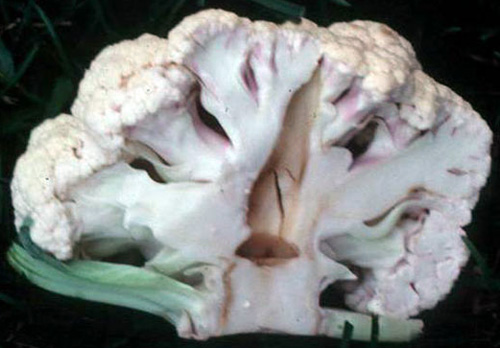Boron in vegetables: Not too little, not too much
Boron is an important micronutrient in many plant systems. However, it needs to be applied with caution.
After a plant’s macronutrient (N, P, K, Ca and Mg) needs are met, there are several micronutrients that come into play that can limit maximum yields. One of the more critical micronutrients to some plant systems is boron (B). Boron is important in protein synthesis; seed and cell wall formation; pollen grain germination and pollen tube growth and, therefore, fruit set and yield; regulation of carbohydrate metabolism; and sugar translocation. Boron is quite soluble and readily leached in some soil types, especially sandy soils typically used for vegetable production.

Boron deficiency in cauliflower. Photo credit: Carl Rosen, University of Minnesota
Vegetables vary considerably in their B requirements (Table 1) with those requiring high levels having quite dramatic deficiency symptoms. The growing point in deficient plants will break down, resulting in a stunted or rosette appearance; leaves may have a yellowish or reddish cast and members of the cabbage family will often have a hollow stem.
Table 1. Relative response of select vegetables to applied Boron1.
From “Secondary and Micronutrients for Vegetables and Field Crops,” MSU Extension bulletin E-486.
|
Crop |
Boron response |
|
Asparagus |
Low |
|
Broccoli |
High |
|
Cabbage |
Medium |
|
Carrot |
Medium |
|
Cauliflower |
High |
|
Celery |
High |
|
Cucumber |
Low |
|
Lettuce |
Medium |
|
Onion |
Low |
|
Parsnip |
Medium |
|
Pea |
Low |
|
Pepper |
Low |
|
Radish |
Medium |
|
Snapbean |
Low |
|
Spinach |
Medium |
|
Sweet Corn |
Medium |
|
Table Beet |
High |
|
Tomato |
Medium |
|
Turnip |
High |
1Highly responsive crops will often respond to micronutrient additions if the nutrient concentration in the soil is low. Medium responsive crops are less likely to respond, and low responsive crops do not usually respond to fertilizer additions even at the lowest soil micronutrient levels.
Boron requirements range from 0.5 to 3 pounds of available B per acre with 2 pounds per acre a good average. Since B is readily leached from sandy soils and it is not included in a standard soil test, growers with sandy sites should consider adding a B evaluation to their soil test. Boron should not be applied without a test since over-application can lead to toxicity, and there is not much difference between levels that help and levels that hurt. Boron applications should be made to bring mature leaf tissue to between 20 and 100 ppm. Tissue levels over 200 ppm are excessive and can be toxic.
Boron deficiencies can be corrected with foliar or ground applications. By the time foliar symptoms are observed and the cause determined, significant economic damage may have already occurred. So, the small expense of a B test on questionable sites prior to planting is well worth the cost. Once an application level has been established, future tests may be unnecessary. Growers can yearly apply the needed amount as a pre-plant broadcast application. Such small amounts of B are generally needed that granular B products should be well blended with a pre-plant broadcast of N–P–K.
More information on boron and other micronutrients and their application methods can be obtained at your local Michigan State University Extension county office.
References
- “Secondary and Micronutrients for Vegetables and Field Crops,” MSU Extension bulletin E-486



 Print
Print Email
Email




